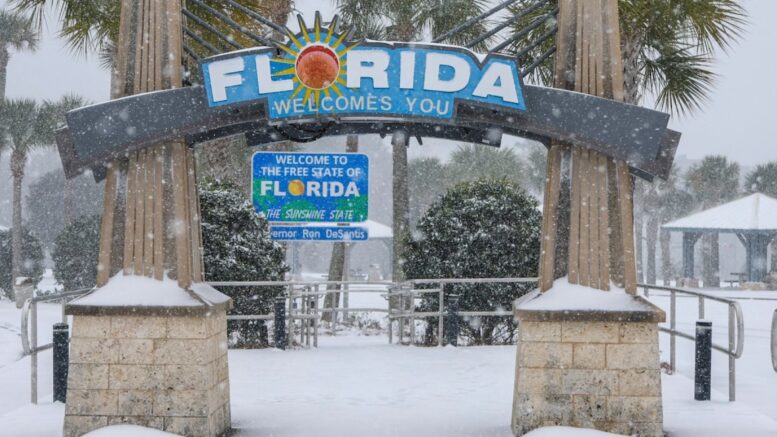By Wylie Saviello
From the most devastating hurricanes the nation has seen in years to record-breaking snowfall in Northeast Florida, 2024 and 2025 have seen extreme weather. After such wild events, some wonder if the weather’s severity may be due to bigger factors, like global warming and climate change.
Hurricane Helene in September of 2024 was the deadliest hurricane to strike the U.S. mainland since Katrina in 2005. Following closely behind was Hurricane Milton, who brought a 10-foot storm surge and spawned dozens of destructive tornadoes across South Florida.
Only several months later, beginning Jan. 19, came record-breaking low temperatures and a winter storm that dropped historic snowfall for several areas in the South.
“Especially in the western panhandle… it really was a once in a lifetime event. It was kind of cool to live through,” said FSU climatologist and member of the Florida Climate Center, David Zierdan, regarding the January snowstorm.
The collision of Gulf moisture with such cold, dry air created a lake-effect snowstorm across the South, according to the National Oceanic and Atmospheric Administration. The southward dip in the jet stream that brought this cold air outbreak was aligned with a stretching event in the stratospheric polar vortex that some recent scientific research has linked to climate change.
The theory proposes that as the whole jet stream system and polar vortex slows down, arctic air and winter intrusions could actually become more likely. What is causing the change in storm patterns, intensity and frequency, is a complicated issue and subject of debate in the science community.
“I don’t think the observations actually support that, but it’s a very interesting theory,” Zierdan said.
The World Meteorological Organization has confirmed that 2024 is the warmest year on record, based on six international datasets. The past ten years have all been in the Top Ten, in an extraordinary streak of record-breaking temperatures.
More record-breaking weather was set on Jan. 21, when 10.0 inches of snow was recorded near Pensacola, Fla., surpassing the record for the snowiest day ever recorded in the state of Florida in 1954.
“It was definitely an exceptional event… prior to Jan. 21 our state record snowfall was 4 inches in Milton, Fla.,” Zierdan said. “I didn’t think I’d see anything like that ever again, until this year, January 21.”
The winter storm certainly was one of a kind. The storm, named Enzo, brought record-breaking cold temperatures and historic snowfall to Louisiana, Texas and Alabama. Such extreme weather brings questions of how climate change may be the source.
“For us as environmental advocates, the winter storms and both the increased frequency and intensity of the storms is further evidence that climate change is having an effect,” said Logan Cross of the Northeast Florida chapter of the Sierra Club. “We are of the view that global warming is the driving force behind it.”
While connecting climate change to a single weather event is difficult, groups like the Sierra Club say it’s about going and taking action.
“It’s gonna get hotter in the winter than in the summer, at night than during the day, and at the poles rather than at the equator,” said Allen Tilley, professor emeritus at the University of North Florida and member of the Sierra Club’s Northeast Florida chapter. “As time goes on, Florida will be conditioned in ways that they haven’t really begun to cope with yet.”
The Sierra Club is trying to create awareness among the Jacksonville City Council about the importance of metro areas addressing climate change through the reduction of carbon emissions.
The Sierra Club has prevented the building of 250 coal plants through their Beyond Coal campaign. Additionally, their Beyond Gas campaign is trying to get the Jacksonville Electric Authority, who is considering replacing a coal plant in the north area of the city with a cheaper gas plant, to build a solar farm instead.
“If we can control our [carbon] emissions, if we can pull down some of the heat that’s already built up in the atmosphere… we’ll never get back to where we were, but we can get back to a sustainable world with milder weather,” Tilley said.
On the individual level, there are plenty of ways to reduce your own carbon footprint and combat climate change. Converting to energy efficient home appliances, choosing biking or walking over driving, buying hybrid or fully electric cars and paying attention to where local political candidates stand on climate change and addressing issues of Florida are just a few examples.
Cross believes the severe winter weather this January should bring more attention to the impacts of global warming. He referenced how 2017’s Hurricane Urma spawned a movement in Jacksonville and St. Augustine to become more resilient cities. These severe weather events cause homeowners to make necessary efforts to protect their homes.
“Sometimes extreme weather can illustrate for people how things have changed,” Cross said.




Be the first to comment on "What a year of wild weather says about climate change"